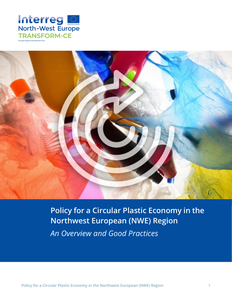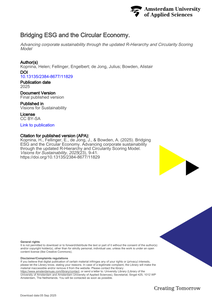This article investigates the phenomenon of rebound effects in relation to a transition to a Circular Economy (CE) through qualitative inquiry. The aim is to gain insights in manifestations of rebound effects by studying the Dutch textile industry as it transitions to a circular system, and to develop appropriate mitigation strategies that can be applied to ensure an effective transition. The rebound effect, known originally from the energy efficiency literature, occurs when improvements in efficiency or other technological innovations fail to deliver on their environmental promise due to (behavioral) economic mechanisms. The presence of rebound in CE contexts can therefore lead to the structural overstatement of environmental benefits of certain innovations, which can influence reaching emission targets and the preference order of recycling. In this research, the CE rebound effect is investigated in the Dutch textile industry, which is identified as being vulnerable to rebound, yet with a positive potential to avoid it. The main findings include the very low awareness of this effect amongst key stakeholders, and the identification of specific and general instances of rebound effects in the investigated industry. In addition, the relation of these effects to Circular Business Models and CE strategies are investigated, and placed in a larger context in order to gain a more comprehensive understanding about the place and role of this effect in the transition. This concerns the necessity for a new approach to how design has been practiced traditionally, and the need to place transitional developments in a systems perspective. Propositions that serve as theory-building blocks are put forward and include suggestions for further research and recommendations about dealing with rebound effects and shaping an eco-effective transition. Thomas Siderius, Kim Poldner, Reconsidering the Circular Economy Rebound effect: Propositions from a case study of the Dutch Circular Textile Valley, Journal of Cleaner Production, Volume 293, 2021, 125996, ISSN 0959-6526, https://doi.org/10.1016/j.jclepro.2021.125996.
DOCUMENT

This document combines four reports on existing regional business support programmes for inclusion or understanding of circular economy (CE) objectives, deliverable DT3.1.2 from the transform-CE project. Besides a general overview on national and regional level, the focus is on a selection of national and regional programmes aimed at the plastics industry. After explaining the format to structure the programmes, the results for the four regions are presented: Greater Manchester (UK), Rhineland Palatinate and North-Rhine Westphalia (DE), Wallonia (BE), Central Netherlands (NL).
MULTIFILE

This lessons learned report gives an overview of the output and results of the first phase of the REDUCES project. The introduction states the relevance of combining a policy approach with business model analysis, and defines the objectives. Next, an overview is given of circular economy good business practices in the regions involved. Examining these business practices helped to define the regional needs for circular economy policy. This business approach proved to be a solid base for developing regional circular economy action plans, the last chapter of this report.
DOCUMENT

This report describes the Utrecht regio with regard to sustainability and circular business models.
DOCUMENT

This paper explores the relationship between Circular Economy (CE) and Environmental, Social, and Governance (ESG) frameworks—a connection that remains ambiguous in both academic literature and practical application. This lack of clarity hinders corporate accountability and progress toward sustainability goals. To address this, we examine how CE and ESG intersect by integrating relevant theories and practical approaches. We identify key strategic overlaps across diverse CE and ESG indicators and frameworks, demonstrating how each can inform and strengthen the other. We begin by outlining foundational theories and current practices in both CE and ESG, then explore how their integration can enhance organisational alignment and accountability, particularly in the environmental dimension of ESG. To support this synergy, we propose an updated 10-R framework for qualitative reporting, incorporating new dimensions such as Regeneration (e.g., Rewilding and Restoration) to reflect biodiversity considerations. Additionally, we introduce the Circularity Scoring Model (CSM) to assess organisational CE performance concerning ESG objectives quantitatively. Our findings suggest that embedding CE principles into accounting and investment practices can highlight opportunities for improvement, such as transitioning to renewable energy, sourcing alternative materials, extending product lifespans, enhancing repairability, minimising waste, and increasing use of recycled or regenerative resources.
DOCUMENT

The circular economy (CE) is heralded as reducing material use and emissions while providing more jobs and growth. We explored this narrative in a series of expert workshops, basing ourselves on theories, methods and findings from science fields such as global environmental input-output analysis, business modelling, industrial organisation, innovation sciences and transition studies. Our findings indicate that this dominant narrative suffers from at least three inconvenient truths. First, CE can lead to loss of GDP. Each doubling of product lifetimes will halve the related industrial production, while the required design changes may cost little. Second, the same mechanism can create losses of production jobs. This may not be compensated by extra maintenance, repair or refurbishing activities. Finally, ‘Product-as-a-Service’ business models supported by platform technologies are crucial for a CE transition. But by transforming consumers from owners to users, they lose independence and do not share in any value enhancement of assets (e.g., houses). As shown by Uber and AirBNB, platforms tend to concentrate power and value with providers, dramatically affecting the distribution of wealth. The real win-win potential of circularity is that the same societal welfare may be achieved with less production and fewer working hours, resulting in more leisure time. But it is perfectly possible that powerful platform providers capture most added value and channel that to their elite owners, at the expense of the purchasing power of ordinary people working fewer hours. Similar undesirable distributional effects may occur at the global scale: the service economies in the Global North may benefit from the additional repair and refurbishment activities, while economies in the Global South that are more oriented towards primary production will see these activities shrink. It is essential that CE research comes to grips with such effects. Furthermore, governance approaches mitigating unfair distribution of power and value are hence essential for a successful circularity transition.
LINK
This chapter will introduce the circular economy (CE) and Cradle to Cradle (C2C) models of sustainable production. It will reflect on the key blockages to a meaningful sustainable production and how these could be overcome, particularly in the context of business education. The case study of the course for bachelor’s students within International Business Management Studies (IBMS), and at University College in The Netherlands will be discussed. These case studies will illustrate the opportunities as well as potential pitfalls of the closed loop production models. The results of case studies’ analysis show that there was a mismatch between expectations of the sponsor companies and those of students on the one hand and a mismatch between theory and practice on the other hand. Helpful directions for future research and teaching practice are outlined. https://www.springer.com/gp/book/9783319713113#aboutBook https://www.linkedin.com/in/helenkopnina/
MULTIFILE

Organizations are currently facing substantial challenges regarding becoming circular by 2050 – also referred to as Circular Economy (CE). Subsequently, increasing complexity on all organizational levels creates uncertainty about respective organizational and technological capabilities and adequate strategies to develop these capabilities. Organizations are struggling in picking up the CE ambitions and answering the what’s in it for me question. Scholars are developing models and frameworks to enable organizations to measure CE performance. Over 125 assessment methods are available for micro level assessment – measuring up to 365 different metrics. Moreover, extant literature is available presenting barriers and opportunities for CE transformation focusing on industry, sector, region, etc. And, although a more holistic perspective is required to become circular mature, this is currently lacking. In this paper we present a multi-methodology view on approaches and how they are used (or not). Our main goal is to extend the existing body of knowledge with an eye on applicability and research directions to untie the Gordian knot of measuring circularity.
LINK
This article addresses European energy policy through conventional and transformative sustainability approaches. The reader is guided towards an understanding of different renewable energy options that are available on the policy making table and how the policy choices have been shaped. In arguing that so far, European energy policy has been guided by conventional sustainability framework that focuses on eco-efficiency and ‘energy mix’, this article proposes greater reliance on circular economy (CE) and Cradle to Cradle (C2C) frameworks. Exploring the current European reliance on biofuels as a source of renewable energy, this article will provide recommendations for transition to transformative energy choices. http://dx.doi.org/10.13135/2384-8677/2331 https://www.linkedin.com/in/helenkopnina/
MULTIFILE

This article describes how Circular Economy (CE) and Cradle to Cradle (C2C) can be used in university teaching to address these frameworks’ strengths and weaknesses in practice. The advantages of these frameworks for radical change are outlined, including their emphasis on upcycling rather than recycling (downcycling). This article discusses how students apply their understanding of transformative production frameworks to three case studies of products or materials. The student projects evaluating existing products in terms of their circularity value outline a number of practical as well as theoretical challenges. The case studies demonstrate that some products still have a long way to go to fully cycle materials within a closed system. Aside from illustrating the dangers of subversion of circular frameworks to the ‘business-as-usual’ scenarios, the assignments are instructive in showing how CE/C2C can be successfully taught. This article recommends pedagogical strategies involving both theory of sustainable production and sustainability and practical research into company’s operations in order to develop the students’ ability to meaningfully engage with CE/C2C models. https://doi.org/10.1080/1943815X.2018.1471724 LinkedIn: https://www.linkedin.com/in/helenkopnina/
MULTIFILE
